

By Walt Meier
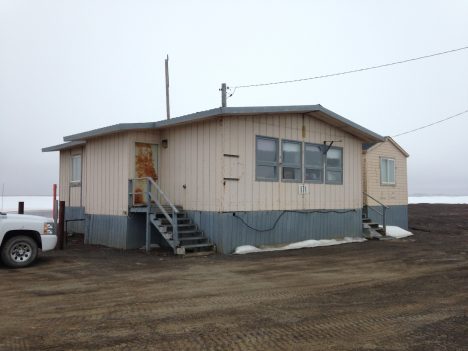
I have arrived in Barrow, Alaska. It was an interesting flight up from Anchorage: the plane had seats only in the back half of the plane because the front half is used for cargo. That is because there are no roads into Barrow, so supplies need to be brought in by plane or, during the short summers, by barge. After a stopover in Prudhoe Bay, we arrived to gloomy skies, which are quite typical for this time of year. Temperatures are right around freezing. We are staying at the NARL, which originally was the Naval Arctic Research Laboratory. Various research groups and other activities –even a college– now share this facility.
The accommodations are spare, but comfortable. Most people are staying in Quonset huts (prefabricated huts made of galvanized steel), but I’m with four others in “The House”, which is more like, well, a house. We have a living room, kitchen, full bath, and four bedrooms. Because we have a kitchen, we are the base for meals where the whole group meets up to eat breakfast and lunch. Last night we all gathered for a light meal after arriving and, with 24 people, it got pretty crowded. But it was nice to catch up with old friends and meet new colleagues. Already the collaborations have begun as we informally discussed each other’s research.
The whole campus is on a narrow spit of land north of town sticking out into the Beaufort Sea. I can see the sea ice from the house. So you might say we’re staying at a beachfront resort! With the ice right out the window, it was tempting to take a walk out there last night. However, we were told to not go out on the ice until we get a safety orientation. The ice off the coast is landfast ice – ice that is attached to the coast, so it doesn’t drift with the winds. However, it can still shift with the tides, as evidenced by piles of ice ridged formed as ice got pushed together. So one doesn’t want to just run out on the ice without being familiar with the hazards. Oh, and there are also potentially polar bears roaming around – another very good reason not to go roaming off by oneself.

Our view of sea ice from The House.
Now we’re heading off to our orientation session and introductory discussions where we’ll start learning about modeling, satellite data, and field observations. This afternoon we’ll take our first trip out onto the ice. When the week is over, each of us will have broadened our expertise beyond each of our core research areas and hopefully we may find new areas of research to collaborate on and advance our understanding of sea ice.
By Walt Meier
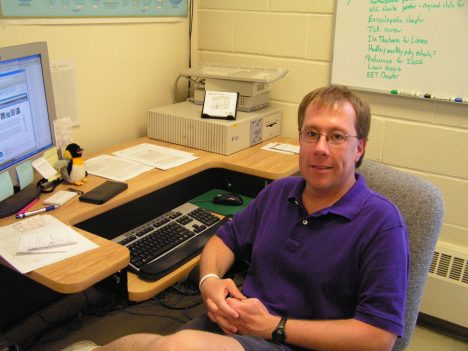
Whenever I tell people that I’m a polar scientist or that I study sea ice, inevitably one of the first questions I’m asked is, “so, have you been to the ice?” I’ve always had to answer no. I’m a remote sensing scientist who works with satellite data. Other than a few aircraft flights over the ice several years ago, I’ve spent my career in front of a computer analyzing satellite images. When I’ve needed field data, e.g., to validate satellite measurements, I could always obtain it from colleagues. So there has never been any need for me to go out on the ice. And to be honest, spending days or weeks in the field, as many researchers do, does not have particular appeal to me – I like the comforts of my heated office! Nonetheless, I’ve always wanted to get out at least once in my career and see the ice close up, feel it crunching under my feet, hear it creak and groan as it strains under the winds and currents.

An image of sea ice in northwest Greenland, captured by NASA’s Operation IceBridge.
Now I am getting that chance, thanks to a National Science Foundation funded Summer Sea Ice Camp workshop. I and a couple dozen fellow scientists are heading to Barrow, Alaska – the northernmost point in the United States at 71 degrees N latitude – to partake in a unique project. The goal of this project isn’t specifically to collect data (though I hope that some of the data we collect will be useful), but rather to foster communication between remote sensing scientists like myself, sea ice modelers, and field researchers.
While there is a lot of collaboration in the sea ice community in terms of sharing data and results, scientists tend be silo-ed within their own area of expertise when it comes their actual work. Modelers focus on model development, validation, and results. Remote sensing folks like myself analyze satellite data. And field researchers collect and analyze in situ observations. Partly this is simply due to time – just focusing on one area keeps one plenty busy. But it is also partly due to a lack of communication. For example, I know a bit about modeling, but I don’t really understand the details of how a sea ice model is put together, how it can and should be used. Similarly, while modelers often use remote sensing data to compare with their model results, they don’t often understand the capabilities and limitations of satellite data. This can lead to under use or misuse of the data. And neither modelers nor remote sensing scientists may have much understanding of how to best take advantage of in situ data.
The goal of this workshop is to bring the three groups together for a week to talk and work with each other to better understand each of the three specialty areas and how perhaps the three groups can better work with each other to advance our understanding of sea ice. So now I’m on my way to Barrow, Alaska, looking forward to helping others understand satellite data, as well as running sea ice models and feeling that crunch of ice and snow under my feet as I collect data from on top of the Arctic Ocean. More in my next blog post from Barrow!
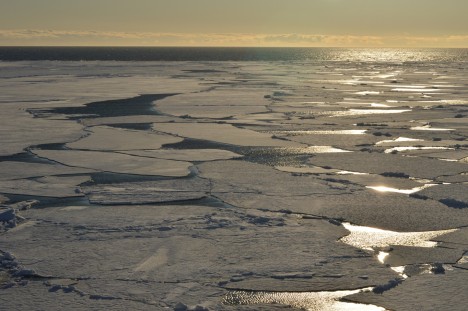
Credit: NASA/Christine Dow
By Christine Dow
We have arrived back safe and sound after 11 days crossing the Southern Ocean. Our exit from Jang Bogo involved one last (very short) helicopter ride taking us to the Araon icebreaker so that they didn’t have to re-break ice to get back into port. I stayed up till the wee hours on the top deck watching us motoring away from my home for the last month, pushing large chunks of sea ice out the way. Some Adélie penguins were also witness to our departure along with snow and cape petrels diving and swooping around the wave tops. It was a very idyllic sight and I was sad to say goodbye to the Antarctic (until next time).

Credit: NASA/Christine Dow
Onward ho. Over the next few days we crashed and bumped our way through the sea ice. This was a good chance to get used to the (very) rolly motion of the boat. Icebreakers are designed with highly rounded keels, excellent for smashing through ice packs but not so great on the stomach. A very good distraction was the on-board table tennis table. Many doubles games were played over the course of the voyage, some more successful than others depending on whether the boat allowed both balls and players to be on a sensible trajectory.
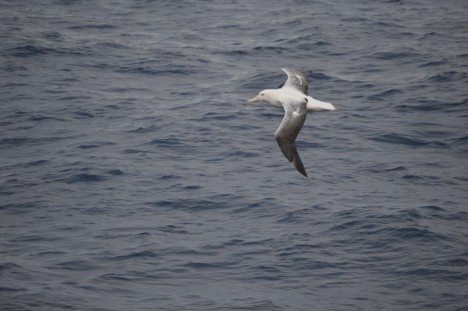
Credit: NASA/Christine Dow
After two days, we were almost out of the sea ice pack when we suddenly had to turn around and return south. There had been a distress call from a fishing boat stuck in the ice and R/V Araon went to the rescue. We successfully hauled the boat free from the ice that it had become wedged on and escorted them to a region easier to navigate through. On the return journey we also stopped to collect some long sediment cores that the Korean scientists will analyze later.
The timing of our journey meant that we had Christmas on board the boat. Our party was on Christmas Eve and involved a veritable feast – the chefs had been very busy all day kindly preparing this for us. One of the Korean scientists also played some clarinet and saxophone music to get us in the Christmassy mood. We even had a Christmas tree, lashed to a railing to stop it flying all over the place.
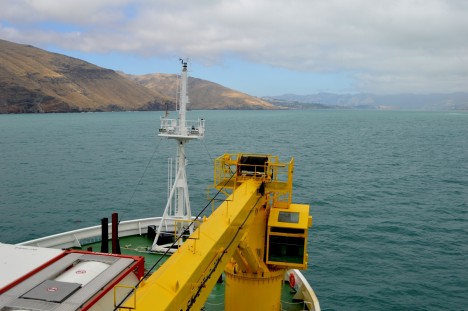
Credit: NASA/Christine Dow
On the 11th day of our journey we could see land. It was very strange to see trees and green again after so long with just hues of blue and white. We had also been slowly getting used to the dark as we moved north following our time in 24-hour daylight; the first sunset of the voyage had been spectacular with giant albatross swooping behind the boat. I watched as we finally docked at the port of Lyttleton in New Zealand, feeling that “normal” life would be a little surreal after our adventure. It was time to say goodbye to our friends and colleagues and go home, just in time for the New Year. After such a trip it’s not surprising that one of my resolutions for the new year is to get back to the frozen continent…some day.
By Ryan Walker
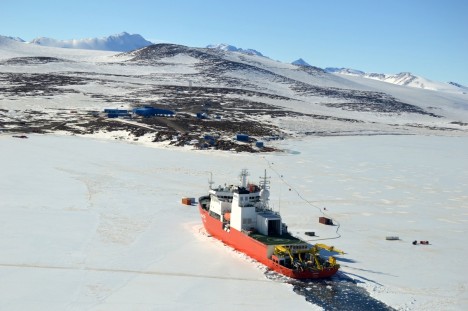
Credit: NASA/Christine Dow
Before it was time to recheck our GPS stations and download data from them, the icebreaker Araon arrived at Jang Bogo, bringing new scientists, a new helicopter crew, fresh food, and other supplies. Because of heavy sea ice cover on the bay, the arrival was in slow motion, taking most of a day from the time the ship was visible from the station until it stopped a few hundred yards offshore due to unbreakable eight-foot-thick ice. Thick ice often requires an icebreaker to back up a considerable way, then charge forward into the ice, breaking through either by pure impact or by sliding the bow up onto the ice, causing it to collapse under the ship’s weight. One passenger told Christine and me that it was “like being in a car crash — all day.” We’re quite happy that there will already be a clear path out of the bay when we take the Araon back to Christchurch. Before leaving again for a roughly week-long science cruise, the ship also dropped off quite a lot of equipment for the various science teams, including most of the instruments to be installed by our hosts, the Extreme Geophysics Group. This meant that the time between Araon’s departure and return would be very busy, with limited time to install instruments before most of the scientists leave on the ship. On top of this, we had several days of bad weather that prevented any helicopter flights. In order to finish our work on the GPS stations, we had to squeeze into a busy flight schedule, which meant that Christine and I would go on separate flights.
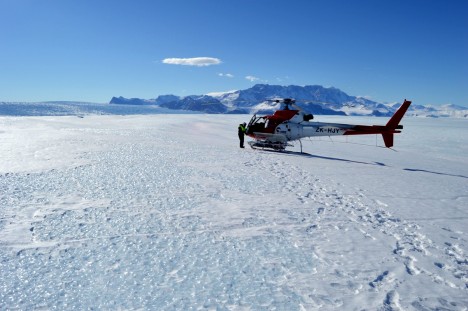
Credit: NASA/Christine Dow
I was on the first flight on December 10, which began with Dr. Choon-ki Lee installing a new GPS station on a large piece of ice at the front of Nansen Ice Shelf that looks ready to calve off into a tabular iceberg. There’s a huge crack, miles long and sometimes over a hundred yards wide, which runs more or less parallel to the front of the ice shelf. Over the winter, the sea surface freezes and traps small icebergs in the crack, producing a fascinatingly broken icescape. Comparing ice velocities between this new GPS and our stations should let us monitor the calving process and learn more about how it works. When we moved on to check the first of our GPS stations, I found that it wasn’t operating at all. After checking the wiring, I worked out that the problem was either in the wire to the receiver, the regulator (the electrical component that connects the solar panel, battery, and receiver), or the GPS receiver itself (potentially big trouble) — but had no idea which one. I pulled out those three components to check back at Jang Bogo, and we secured the rest of the station and moved on. Fortunately, after an unpromising start, the two other GPS stations we visited were working perfectly. While downloading the data, which involved about fifteen minutes of connecting my laptop and then sitting on the ice typing obscure commands, I was amused by how much this aspect of field work resembled the computer modeling work I usually do, though with vastly better scenery. We then returned to Jang Bogo with two stations in good shape, two yet to be checked, and one hopefully to be repaired.
Christine says: It was getting worryingly close to the time when we would be leaving the Antarctic and we still had some data to collect and the GPS to fix. I found that the GPS problem had been due to a faulty solar regulator and replaced it with a spare back at base. Luckily I managed to piggy back on a flight out to the Nansen Ice Shelf with the Extreme Geophysics Group while they were putting out seismic stations. Replacing the GPS was quick, with the satellite lights blinking encouragingly; now we just have to hope the system will continue working for the next couple of months. At the next station, I downloaded the data while wind blew some loose snow all over me and the computer. I probably looked a little like a snowman by the end of that. The final job was to replace the tethers on the last GPS (see our previous blog post). It was not without sadness that I waved goodbye to the plucky little machines, which would sit out on the ice on their own until the end of February. At that stage one of our Korean colleagues who is overwintering at Jang Bogo will collect them for us and send them back on the ship.
Speaking of the ship, we’re off. It is due to arrive tomorrow and we will set sail for our 7-10 day ‘cruise’ back to Christchurch in New Zealand. Its hard to believe we’ve been here 5 weeks already and it feels a bit strange to be packing up and leaving. We’re hoping for some wildlife spottings on the boat and more importantly not to be completely debilitated by sea sickness. Internet is not readily available on the Araon so we will report back when we reach dry land. Wish us luck!
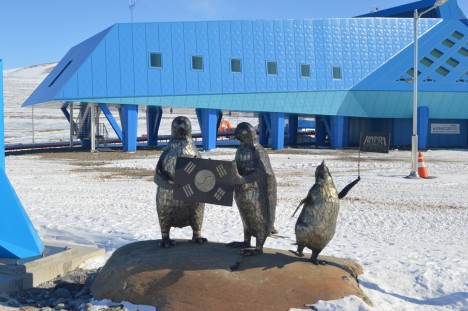
Goodbye, Jang Bogo! (Credit:NASA/Christine Dow)
By Christine Dow
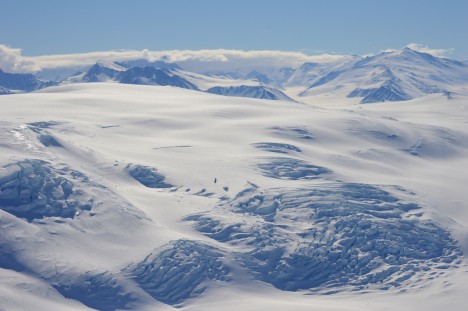
Credit: NASA/Christine Dow
The big day had arrived. We were due to fly to our tiltmeters to collect the data that they had been gathering for two weeks. once this was the first time we had ever set these instruments up in the field, all fingers were crossed that we had been precise enough in initially leveling the meters so the data were in range and also that the solar panels hadn’t ended up covered in snow.
We had a spectacular flight, cutting over the end of Priestley Glacier and skirting helicopter-sized crevasses on the mountain behind our field site. Despite a bit of wind on the Nansen ice shelf, it was as calm on the Comein Glacier as it has always been for our visits. It’s such a peaceful, sheltered spot that I feel a holiday cottage wouldn’t be amiss. Perhaps too long of a commute for an average Friday afternoon, however.
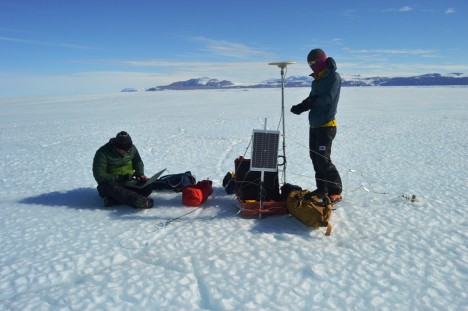
Credit: NASA/Christine Dow
One of the tiltmeters (which are in black boxes) had become exposed and, because black materials absorb heat whereas white materials reflect it, had caused a bit of local melt which had trickled down the side of the box and refrozen. The upshot of this was that the entire box, battery, and straps were encased in some pretty solid ice. Fun! Commence some delicate hacking with ice axes so that we didn’t snap the wires coming out of the box. Finally having reached the interior, we nervously extracted the SD card and Ryan pulled the data off onto the computer. Success! Some excellent (and exciting) looking data showing tidal cycles. Tiltmeter two was easier because it hadn’t caused local melt of the snow so we could quickly retrieve the data. Again, some very interesting outputs. We want to thank John Leeman, an engineer from Penn State, for building us some happily working tiltmeters. Of course having disturbed the tiltmeters I had to reset them back to full level, which required sitting for 10 minutes enjoying the view while very delicately adjusting the little leveling legs.
We had just enough time to collect data from one of the GPS closest to the tiltmeters. All looked well apart from our tethers, which had come loose because of melt on the surface. We had one bamboo tether and one metal peg. The metal had heated up and melted a groove in the ice as it was pulled along, whereas the bamboo had stayed where it was supposed to. We tightened the wire as much as possible but we would have to return to this site with some more bamboo later.
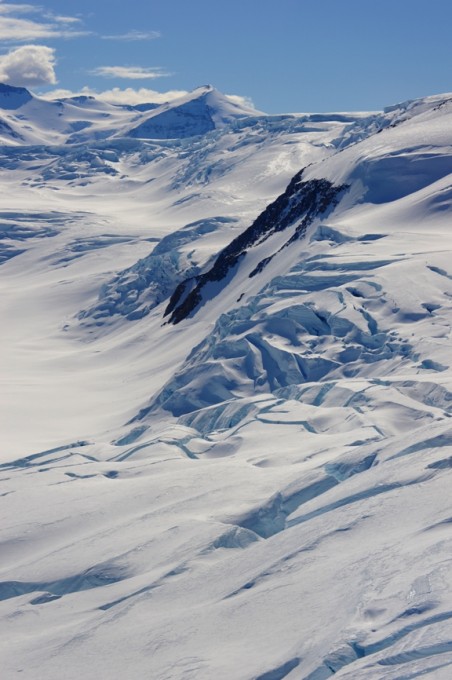
Credit: NASA/Christine Dow
Dinner back at base was a happy affair, having achieved success for at least three of seven of our instruments. The chefs had even made some pizza for us, which was a nice treat. The only unfortunate aspect of the day was that I had forgotten that in areas with 24 hour sunshine and highly reflective snow surfaces it is essential to put sunscreen up your nose as well as on it. Burnt nostrils are not fun, but they’re worth it for some nice data.